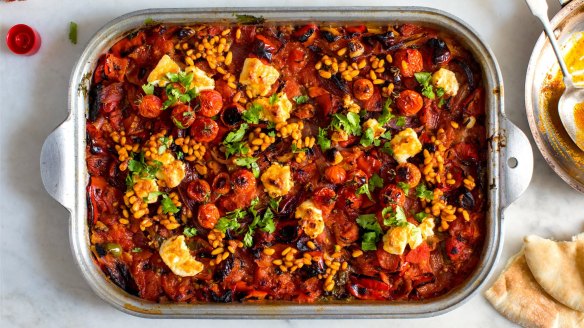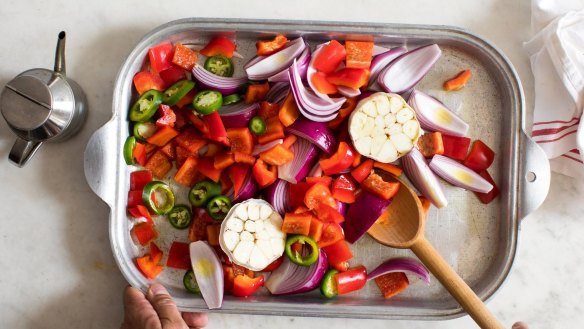Yotam Ottolenghi's warm salad to sizzle up summer

When you hear "summer salad", I bet the first thing that comes to mind isn't a bunch of vegetables cooked within an inch of their lives and left to hang out so their juices meld and their flavours turn hearty and complex. These kinds of techniques are usually left to robust meaty stews or wintry soups and not applied to the cream of the summer's freshest and juiciest crop.
In reality, some of the best and most wonderful dishes using summer's glut are doing just that and with huge success. They may not look like your typical salad; they can also be seen as dips or spreads. But salads are what they are because they keep the integrity of the vegetables as they are mixed together, and they are mostly served cold, alongside other dishes.
Though you can find cooked salads all around the northern and eastern Mediterranean – French ratatouille and Italian peperonata are variations on the theme – I find that the best examples are served in North Africa, particularly in Morocco and Tunisia. This is where you will often find little bites of exquisitely cooked vegetables, served alongside fresh raw salads. Called kemia, they are the equivalent of mezze or tapas in other parts of the region.
Taktouka is one of my favourites: It involves grilling green capsicum over fire or in the oven and then cooking it slowly in a pan with chopped tomatoes, garlic, cumin and lots of olive oil. It gets better after a day or two, once the flavours have been left to develop and the ingredients to interact and amalgamate. Zaalouk is another popular variant, in which eggplant takes the place of the capsicum; they can be grilled first or cooked throughout in the pan with the tomatoes.
I am not sure which came first, these cooked salads or the soft white North African breads they are often served with, but for me they are inseparable. Each is actually a good reason for the other's existence: The bread is essential for soaking up every bit of the splendidly flavoured salad juices, while the salad atop a slice lifts it to new bready heights.
Grilling all or some of the vegetables before cooking them in the pan is a way of intensifying the flavours and adding a bit of char, smoke and bittersweetness to the mix. In mechouia, a Tunisian salad made with capsicums, onions and tomatoes, all the vegetables are first grilled well and then minced. The underlying flavour of the grill is both unmistakable and totally seductive, just as it is in mechouia's more famous cousin from the eastern Mediterranean: the eggplant salad baba ghanoush.
There are, in fact, countless variations on all of these salads, differing regionally and even from one family to the next. Ingredients such as zucchini, carrots, pumpkins or potatoes are often thrown into the mix, as well as hot chillies, lemon juice and spices such as caraway and cinnamon.
This inherent flexibility you have with the ingredients, coupled with the different ways you cook them, is a reason to celebrate these salads and the wonderful tapestry they create.
Another reason to rejoice, which is perhaps more relevant to a modern cook with a busy life, is the versatility of these salads – the many different uses they have. This is really what I had in mind when I created my own take on these North African dishes: charred tomatoes with feta, cooked in the oven from start to finish.
Starting off, it can be served hot as a chunky sauce over cous cous, pasta or rice. Once it has cooled down a little, you can serve it as condiment to meat or alongside other vegetable dishes to create your own kemia. Finally, you can put it in a jar and keep in the fridge for a couple of days (I'd remove the feta for this), ready as an instant sandwich filler or to proudly reappear on the table with a bunch of other summery salads.

Grilled tomatoes and onions with feta-harissa pine nuts
INGREDIENTS
75ml olive oil
450g red onions, each peeled and cut through the core into 8 wedges
2 red capsicums (285g), seeded, stemmed and cut into 3-centimetre pieces
2 jalapenos, cut into 1-centimetre-thick rounds, stems discarded
1 bulb garlic, halved horizontally, cloves split in half
1.5kg roma tomatoes
½ cup (20g) roughly chopped fresh coriander, plus 1 tbsp, for garnish
1 tbsp coriander seeds
sea salt
115g cherry tomatoes with the vine attached
115g Greek feta, roughly crumbled into large chunks
¼ cup (25g) pine nuts
½ tbsp harissa paste
METHOD
1. Heat the oven to 245C. Bring a large pot of water to a simmer over medium-high heat.
2. Add 2 tablespoons oil, the onions, capsicums, jalapenos and garlic to a large 26cm-by-34cm roasting tin and give everything a good stir. Bake for 25 minutes, stirring two to three times, until softened and well charred. Remove the garlic halves and use a small knife to remove the cloves, adding them back into the roasting tin and discarding the papery skins.
3. Meanwhile, use a small knife to remove the core from the roma tomatoes and then carve a small X across the bottom of each tomato. Add half the tomatoes to the simmering water and blanch just until the skins begin to pull away from the flesh, about 30 seconds. Using a slotted spoon, transfer the tomatoes to a large colander to drain, then repeat with the remaining tomatoes. Once cool enough to handle, peel the tomatoes, discarding the skins, then roughly chop the flesh, seeds and all.
4. Add the tomatoes, ½ cup coriander, coriander seeds and 1¾ teaspoons salt to the roasting tin and use the back of a large spoon to mash everything together, breaking up the garlic and jalapenos a little. Return to the oven for another 35 minutes, stirring twice throughout, or until the tomatoes have broken down and the mixture has thickened. Remove from the oven and set the oven to the grill setting.
5. Top the charred vegetables with the cherry tomatoes and feta and drizzle with 1 tablespoon of oil. Return to the oven on the middle rack and grill until the feta and cherry tomatoes have taken on some colour, 10 to 15 minutes.
6. Meanwhile, heat the remaining 2 tablespoons of oil in a small frypan over medium-high. Once hot, add the pine nuts and cook until golden, shaking the skillet frequently, 1 to 2 minutes. Carefully stir in the harissa, then transfer to a small bowl.
7. When ready to serve, spoon the harissa pine nuts all over the vegetables and sprinkle with the remaining coriander.
Serves 4
©The New York Times
Appears in these collections
More:
From our partners
Original URL: https://www.theage.com.au/goodfood/yotam-ottolenghis-most-versatile-summer-salad-20200122-h1l87z.html